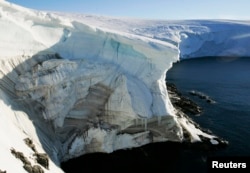A new study of ice formation in Antarctica could challenge conventional wisdom that the continent is losing land ice.
Writing in the Journal of Glaciology, NASA said satellite data showed that the Antarctic ice sheet gained 112 billion tons of ice per year from 1992 to 2001. That slowed to 82 billion tons annually from 2003 to 2008.
But the gains were not uniform around the continent.
“We’re essentially in agreement with other studies that show an increase in ice discharge in the Antarctic Peninsula and the Thwaites and Pine Island region of West Antarctica,” said Jay Zwally, a glaciologist with the NASA Goddard Space Flight Center in Greenbelt, Maryland, and lead author of the study. “Our main disagreement is for East Antarctica and the interior of West Antarctica – there, we see an ice gain that exceeds the losses in the other areas.”
Zwally added that his team “measured small height changes over large areas, as well as the large changes observed over smaller areas.”
Zwally cautions that the gains in one area could be offset by loss in another.
“If the losses of the Antarctic Peninsula and parts of West Antarctica continue to increase at the same rate they’ve been increasing for the last two decades, the losses will catch up with the long-term gain in East Antarctica in 20 or 30 years,” he said. “I don’t think there will be enough snowfall increase to offset these losses.”
Zwally and his team reached their conclusions by measuring the height of the ice sheet using two satellites.
Previous gains in ice elevation in East Antarctica have been attributed to increased snow accumulation, but Zwally said meteorological data shows snowfall in the region decreased by 11 billion tons per year.
The researchers also used ice core samples to analyze snowfall over tens of thousands of years. That suggested the thickness of the ice in East Antarctica has been increasing for a long time.
“At the end of the last Ice Age, the air became warmer and carried more moisture across the continent, doubling the amount of snow dropped on the ice sheet,” Zwally said.
Over the years, that snow has compacted to become ice, which is thickening at a rate of 1.7 centimeters per year. This is enough to more than offset the loss of ice in other areas of the continent.
“The good news is that Antarctica is not currently contributing to sea level rise, but is taking 0.23 millimeters per year away,” Zwally said.










